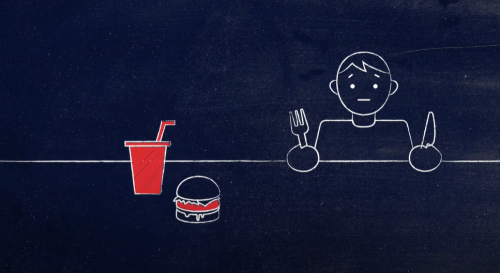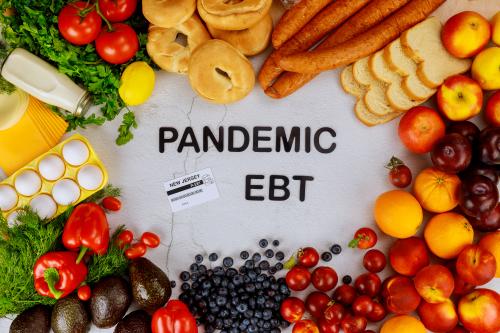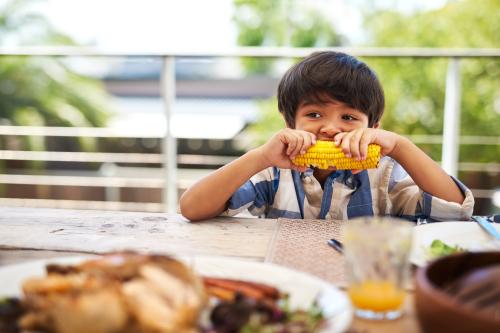The COVID-19 pandemic has shaped 2020 into a year characterized by public health and economic crises in the United States, destabilizing millions of families. One of the most striking and consistent indicators of ongoing hardship is an elevated level of food insecurity in American households. Food insecurity sits at the intersection of the economy and health; it is measure that a household lacks sufficient resources to provide adequate nutrition to its members.
This analysis provides evidence of an ongoing food insecurity crisis in the United States and current evidence on very low food insecurity among children by child age. I find that while fewer parents report that their children do not have sufficient food in October than earlier in the pandemic, two surveys both find that almost 10 percent of parents of young children – those who only have children between the ages of zero and five – report that their kids do not have sufficient food and they lack the resources to purchase more.
I also provide descriptive evidence on the relationship between income losses and nutrition assistance program receipt on the incidence of food insecurity during October 2020. Food insecurity is a leading indicator of economic distress; food insecurity tends to rise before poverty rates catch up. I find that low-income families with children are most likely to have experienced an income loss and most likely to have an income loss coincide with reporting very low food security among the household’s children. While the food safety net supports many families – the majority of low-income households report both nutrition assistance program participation and no very low food security among children – low-income families still struggle to make ends meet even with these supports.
Trends in Food Insecurity
Prior to the COVID-19 pandemic, the prevalence of moderate to severe food insecurity in the United States had continued its downward trajectory following the Great Recession. Since the onset of the COVID-19 pandemic, food insecurity has increased in the United States. Figure 1 shows that in 2020, food insecurity among all households and households with children remained elevated over 2019 levels and levels of food insecurity reported during the Great Recession. (Please see the accompanying technical appendix for additional detail.) Food insecurity rates have declined since summer due to income support remaining from federal fiscal support packages passed earlier in 2020, declining unemployment as states have reopened their economies in recent months, and some children returning to school in some states, expanding the reach of school meal programs.

In 2019, in only about 0.5 percent of households with children did children ever experience reductions or disruptions in their food intake over the past 12 months. It is on this question– whether parents report that their children aren’t getting enough to eat due to a lack of resources – that there has been a spike since March. Figure 2 shows the share of parents (Census Household Pulse Survey; light green and light blue) and the share of mothers (Brookings Survey of Mothers with Young Children; dark green and dark blue) who responded that it was sometime or often the case that “The children in my household were not eating enough because we just couldn’t afford enough food.” (The time period about which the respondents were asked varied across surveys; please refer to the technical appendix for additional details. The green bars show rates for families where at least one school-age child is present while the blue bars are limited to families whose children are 5 and younger; these groups are exclusive.)

From the onset of the pandemic to November, fewer mothers and parents are currently reporting that their children did not have enough to eat and they lacked the resources to purchase food.
- In the Survey of Mothers with Young Children, twelve percent of mothers who only have children 5 and under reported that their children didn’t have enough to eat in April compared with ten percent in October and November.
- In the Pulse survey, which has a larger sample and surveys both mothers and fathers, there has been a statistically significant decline in the share of parents reported that their children did not have enough to eat, both for parents of school-age children (17 percent in June to 12 percent in October) and parents who have children younger than school-age (12 percent to 10 percent).
However, even as food insecurity is declining, the share of parents, especially parents of children younger than five, who report that their children are not eating enough is quite high by historic standards.
Food Insecurity and Household Resources
A typical feature of recessions is that those who had fewer means before the downturn suffer more during downturns and for longer. Indeed, the loss of a job or income, as well as unstable child care arrangements are associated with the onset of food insecurity. The downturn instigated by the COVID-19 pandemic is also likely to increase food insecurity even more: the loss of child care, as well as meals provided at free or reduced cost at school and social distancing guidance that restrict movement outside the home.
During the COVID-19 pandemic, low-income families with children have been the most likely to have lost earned income during 2020. About 50 percent of families with school-age children and 44 percent of families only with children who are below school-age reported in October that they had experienced a loss of income during the pandemic. Of the parents reporting that their children do not have sufficient food, 73 percent of parents of school-age children and 71 percent of parents of only younger children also reported experiencing an income loss.
More families reported that there was an income loss and very low food insecurity among children than no income loss and very low food insecurity among children at every income level. Figure 3 shows the joint distribution of income losses and very low food security among children by 2019 household income using Pulse data from October 14 to 26, 2020. While one-third of households with children with 2019 incomes above $150,000 reported an income loss, about 60 percent of families making below $50,000 in 2019 did. One-third of households with children making less than $25,000 a year, more than one in five households with incomes between $25,000 and $50,000 and one in eight families with incomes between $50,000 and $75,000 reported very low food security among children. In addition to the direct relationship between diminished purchasing power and children having insufficient food, the loss of prepared school meals, supply chain issues, and rising food prices make it harder to stretch a dollar.

Because this is both an economic and public health crisis, safety net programs have expanded to provide federal nutrition assistance resources to households. The Supplemental Nutrition Assistance Program (SNAP; formerly known as The Food Stamp Program) is the primary means through which the federal government addresses food insecurity. A new program – Pandemic EBT – is set up to function like SNAP. Pandemic EBT provides a voucher to purchase groceries for children who otherwise would have received free or reduced-price meals during school. These programs along with other children nutrition programs – such as the National School Lunch Program, Breakfast Program, and Summer Meals programs – WIC, and some smaller programs comprise the federal food safety net. Figure 4 shows 2020 monthly spending on nutrition assistance programs through October. Outlays accelerated after March and peaked in June, as the bulk of Pandemic EBT benefits were disbursed. Disbursements in October for both the child nutrition programs and for SNAP and Pandemic EBT were higher in October than in September.

Figure 5 shows the distribution of mothers with children 12 and under who reported participating in at least one of the federal nutrition assistance programs – SNAP, Pandemic EBT, WIC, or prepared school meals – against whether or not they reported that their children were not eating enough and they lacked the resources to buy more food in October and early November. The majority of households with income below $49,000 report both food safety net participation and no very low food security among children; but among mothers who reported that their children did not have sufficient food, a higher share reported food safety net participation than not. That these families who receive benefits remain food insecure does not imply that the programs are ineffective, as those who are most in need of food assistance are most likely to enroll in nutrition programs. Furthermore, benefit inadequacy is more impactful among lower-income families; for those with incomes above $50,000, fewer households who availed themselves of the food safety reported that their children had inadequate food than those who did not.

Several policy responses to the COVID-19 pandemic have supported households’ food security. With my colleagues Diane Schanzenbach, Abigail Pitts, and Krista Ruffini, we evaluated the effect of Pandemic EBT on measures of food hardship. We found that Pandemic EBT reduced very low food security among children by 30 percent in the week after disbursements. Other scholars have found during COVID-19 that Unemployment Insurance receipt and SNAP emergency allotments also reduced food insecurity.
Conclusion
There are immediate and long-term health consequences to inadequate nutrition and limited access to food. Children born into food insecure households risk birth defects and children living in food-insecure households tend to have a lower health-related quality of life, higher rates of asthma, less nutritious diets, anemia, and cognitive and behavioral problems that affect well-being and school performance.
In the first five years of life – the foundational years for brain and physical development – food insecurity directly and indirectly impedes healthy development. That parents of children younger than five are reporting such high rates of very low food security among their children, almost 10 percent in two surveys fielded in October, is of urgent public concern.
Deteriorating economic conditions caused by the COVID-19 pandemic have made it even more difficult for many low-income households, including those with children, to afford groceries. While federal nutrition assistance programs have expanded as families have lost income and through Congressional action, elevated levels of very low food security among children necessitate additional action.
While Congress reauthorized Pandemic EBT to operate during the 2020-21 school year, the US Department of Agriculture did not issue guidance regarding state plans until November 16. A delay in implementing Pandemic EBT for this school year is exacerbating food insecurity issues in households as COVID cases accelerate and more students are engaged in remote learning. School districts, states, and USDA should work together to hasten timelines for distributing benefits, starting with SNAP-eligible households. Furthermore, while lump sum payments will be necessary in the beginning to make up for the current gap in coverage, efforts should be made to allow for monthly Pandemic EBT disbursements through September 2021.
In addition to increasing the maximum SNAP benefit by 15 percent, Congress should consider introducing a young child multiplier, which Diane Schanzenbach and Hilary Hoynes provide evidence for in a policy proposal for the Washington Center for Equitable Growth. This would increase SNAP benefits for families with children below the age of five and would fill a gap the Pandemic EBT’s welcome extension does not completely.
The technical appendix is available here.
The Brookings Institution is committed to quality, independence, and impact.
We are supported by a diverse array of funders. In line with our values and policies, each Brookings publication represents the sole views of its author(s).







Commentary
Hungry at Thanksgiving: A Fall 2020 update on food insecurity in the U.S.
November 23, 2020